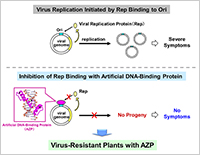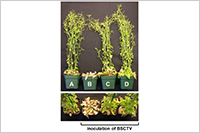Enlarge Image Figure 2: Creation of virus-resistant plants with AZP. Plant A is a healthy wild plant without virus infection. Inoculated BSCTV to plants B, C and D. Stem of the wild plant (Plant B) stopped growing and died 4 weeks after BSCTV inoculation. In contrast, AZP-transgenic plants (Plants C and D) showed complete virus resistance. In our AZP-transgenic plants with no symptoms, viral DNA was not detected at all by Southern blot analysis.
Enlarge Image
Immunizing plants: Creation of virus-resistant plants with artificial DNA-binding proteins
In order to resolve global food crisis, it is important to prevent plant viruses from spreading infections as they infect a wide variety of agricultural crops and significantly reduce yields. For example, gemini-virus, which forms a large family in a DNA virus, has caused over 200 billion yen worth of damage to cassava, which is a major staple food in Africa. So there is demand for effective methods to prevent such damage. A possible solution to this problem is the use of commercially available virus-resistant agricultural crops created by breeding that have some degree of resistance to viral infections. However, such crops become a new source of infection, as it is not possible to eliminate the infected virus from them. Therefore, scientists are still searching for long term solutions.
Takashi Sera and colleagues at Okayama University have developed a new method for preventing DNA virus infection that is based on the idea that it is possible to prevent the development of viral infection symptoms if the virus can be prevented from growing even though it enters into a host plant.
This approach prevents viral infection by inhibiting replication protein (Rep) from binding to its replication origin by using an artificial DNA-binding protein capable of binding strongly to a target DNA sequence. To demonstrate the effectiveness of this method, the researchers used Arabidopsis, an experimental plant, and beet severe curly top virus (BSCTV), a DNA virus. BSCTV was chosen because it is known to strongly infect and kill many plants including Arabidopsis.
Based on this method, the researchers developed an artificial DNA-binding protein that binds 1,000 times more strongly than the Rep of BSCTV and effectively inhibits binding of Rep. Transgenic plants, Arabidopsis thaliana transformed with the artificial DNA-binding protein, showed no infection symptoms at all even if it was inoculated with BSCTV. Moreover, it should be noted that viral DNA was not detected in the transgenic plants. Namely, this method not only prevents targeted plants from developing viral infection, but also gives immunity (not resistance) to them.
Since the early experiments, the Okayama group have successfully demonstrated the effectiveness of this method for vegetables. “Our latest challenge is to apply this method to cereals,” says Sera. “With the aim of developing a virus-resistant wheat, we created an artificial DNA-binding protein for wheat (designated “Wheat_AZP”). We are currently performing gene transfer into wheat to demonstrate the effectiveness of this method for cereals in the near future.”
・References:
Takashi Sera and Carla Uranga : Rational design of artificial zinc-finger proteins using a nondegenerate recognition code table. Biochemistry 2002, 41, 7074−7081.
DOI: 10.1021/bi020095c
http://www.ncbi.nlm.nih.gov/pubmed/12033941
Takashi Sera : Inhibition of virus DNA replication by artificial zinc-finger proteins. J. Virol. 2005, 79, 2614-2619.
DOI: 10.1128/JVI.79.4.2614-2619.2005
http://www.ncbi.nlm.nih.gov/pubmed/15681461
Tomoaki Mori, Kosuke Takenaka, Fumiya Domoto, Yasuhiro Aoyama, and Takashi Sera : Inhibition of binding of Tomato yellow leaf curl virus Rep to its replication origin by artificial zinc-finger protein. Mol. Biotechnol. 2013, 54, 198−203.
DOI: 10.1007/s12033-012-9552-5
http://www.ncbi.nlm.nih.gov/pubmed/22576255
・Reference(e-Bulletin) :
http://www.okayama-u.ac.jp/user/kouhou/ebulletin/feature/vol14/feature_001.html
・affiliations: Laboratory of Biofunctional Molecules Design, Division of Chemistry and Biotechnology, Department of Biotechnology, Graduate School of Natural Science and Technology, Okayama University
・Department website (Japanese):
http://www.okayama-u.ac.jp/user/seralab/index.html
・Correspondence to: Professor Takashi Sera, Ph.D.
sera(a) cc.okayama-u.ac.jp
For inquiries, please contact us by replacing (a) with the @ mark.


